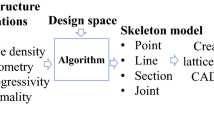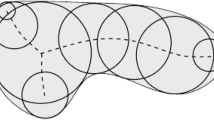Abstract
This paper proposes a framework for generating mesh sizing functions for assembly models. Size control is crucial in obtaining a high-quality mesh with a reduced number of elements. The reduction in the number of elements will decrease computation time and memory use during mesh generation and analysis. The framework consists of a background octree lattice for storing the sizing function, a set of source entities for providing sizing information based on geometric information, and an interpolation module for calculating the sizing on the background octree lattice using the source entities. Source entities are generated by performing a detailed systematic study to identify all the geometric factors of an assembly. Disconnected skeletons are extracted and used as tools to measure 3D proximity and 2D proximity, which are two of the geometric factors. The framework facilitates the generation of a variety of meshes with a low computational cost, to meet industry needs. The framework has been tested on many industrial parts, and sizing control on a few typical assemblies has been presented to demonstrate the effectiveness of the proposed framework.

















Similar content being viewed by others
References
Owen SJ (1998) A survey of unstructured mesh generation technology. In: Proceedings of 7th international meshing roundtable
Lohner R, Parikh P (1988) Generation of three-dimensional unstructured grids by the advancing front method. AIAA-88-0515
Chew LP (1989) Constrained delaunay triangulations. Algorithmica 4:97–108
Cunha A, Canann S, Saigal S (1997) Automatic boundary sizing for 2D and 3D meshes. AMD trends in unstructured mesh generation, ASME, vol 220, pp 65–72
Owen SJ, Saigal S (1997) Neighborhood based element sizing control for finite element surface meshing. In: Proceedings of 6th international meshing roundtable, pp 143–154
Pirzadeh S (1993) Structured background grids for generation of unstructured grids by advancing-front method. AIAA, vol 31
Tracker WC (1980) A brief review of techniques for generating irregular computational grids. Int J Numer Methods Eng 15:1335–1341
Shephard MS (1988) Approaches to the automatic generation and control of finite element meshes. Appl Mech Rev 41:169–185
Zhu J, Blacker T, Smith R (2002) Background overlay grid size functions. In: Proceedings of 11th international meshing roundtable, pp 65–74
Zhu J (2003) A new type of size function respecting premeshed entities. In: Proceedings of 12th international meshing roundtable
Borouchaki H, Hecht F (1997) Mesh gradation control. In: Proceedings of 6th international meshing roundtable
Persson P-O (2004) PDE-based gradient limiting for mesh size functions. In: Proceedings of 13th international meshing roundtable, pp 377–388
Blum H (1967) A transformation for extracting new descriptors of shape. Models for the perception of speech and visual form. MIT Press, Cambridge, pp 326–380
Srinivasan V, Nackman LR, Tang JM, Meshkat SN (1992) Automatic mesh generation using the symmetric axis transformation of polygonal domains. Proc IEEE 80(9):1485–1501
Gursoy HN (1989) Shape interrogation by medial axis transform for automated analysis. MIT Ph.D. Thesis
Gursoy HN, Patrikalakis NM (1992) An automatic coarse and fine surface mesh generation scheme based on MAT, part I: algorithms. Eng Comput 8:121–137
Quadros WR, Ramaswami K, Prinz FB, Gurumoorthy B (2001) Automated geometry adaptive quadrilateral mesh generation using MAT. In: Proceedings of ASME DETC
Quadros WR, Ramaswami K, Prinz FB, Gurumoorthy B (2004) LayTracks: a new approach to automated geometry adaptive quadrilateral mesh generation using medial axis transform. Int J Numer Methods Eng 20:249–264
Quadros WR, Owen SJ, Brewer M, Shimada K (2004) Finite element mesh sizing for surfaces using skeleton. In: Proceedings of 13th international meshing roundtable, pp 389–400
Quadros WR, Shimada K, Owen SJ (2004) Skeleton-based computational method for generation of 3D finite element mesh sizing function. Eng Comput 20(3):249–264
George PL (1991) Automatic mesh generation applications to finite element methods. Wiley
Samet H (1995) Spatial data structures. In: Kim W (ed) Modern database systems: the object model, interoperability, and beyond. ACM Press, Addison-Wesley, pp 361–385
White DR, Saigal S, Owen SJ (2004) An Imprint and merge algorithm incorporating geometric tolerances for conformal meshing of misaligned assemblies. Int J Numer Methods Eng 59:1839–1860
Quadros WR, Shimada K, Owen SJ (2004) 3D discrete skeleton generation by wave propagation on PR-Octree for finite element mesh sizing. In: Proceedings of ACM symposium on solid modeling and applications, Genova, Italy
Owen SJ, Saigal S (2000) Surface mesh sizing control. Int J Numer Methods Eng 47:497–511
Eberly D (2003) Intersection of convex objects: the method of separating axes. Geometric tools, LLC. http://www.geometrictools.com/Documentation/MethodOfSeparatingAxes.pdf. Accessed 05 Jan 2010
Akenine-Möller T (2005) Fast 3D triangle-box overlap testing. In: ACM SIGGRAPH 2005 Courses, Los Angeles, California
3D Content Central (2005). http://3dcontentcentral.com. Accessed 26 June 2005
Knupp PM (2001) Algebraic mesh quality metrics. SIAM J Sci Comput 23:193–218
Quadros WR, Shimada K (2002) HEX-LAYER: layered all-hex mesh generation on thin section solids via chordal surface transformation. In: Proceedings of 11th international meshing roundtable
Author information
Authors and Affiliations
Corresponding author
Additional information
Sandia is a multiprogram laboratory operated by Sandia Corporation, a Lockheed Martin Company, for the United States Department of Energy under Contract DE-AC04-94AL85000.
Rights and permissions
About this article
Cite this article
Quadros, W.R., Vyas, V., Brewer, M. et al. A computational framework for automating generation of sizing function in assembly meshing via disconnected skeletons. Engineering with Computers 26, 231–247 (2010). https://doi.org/10.1007/s00366-009-0164-z
Received:
Accepted:
Published:
Issue Date:
DOI: https://doi.org/10.1007/s00366-009-0164-z




